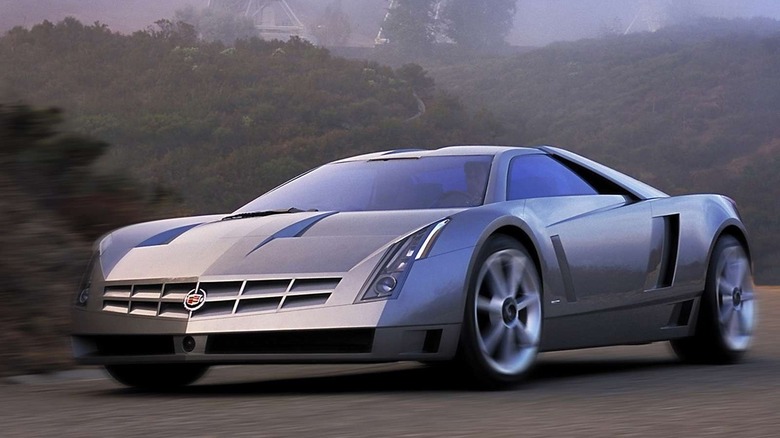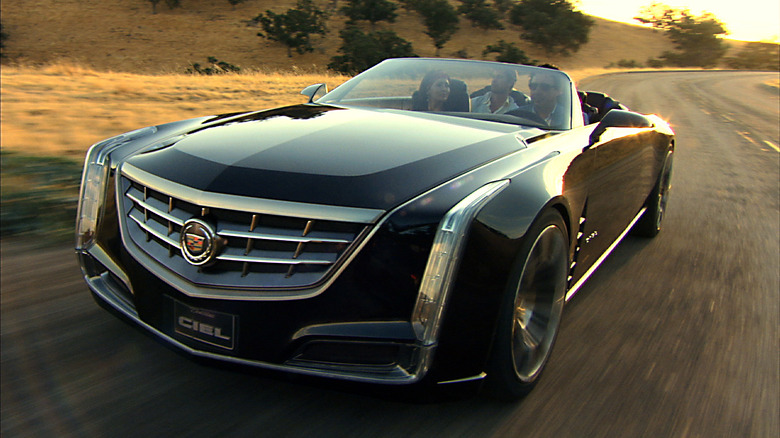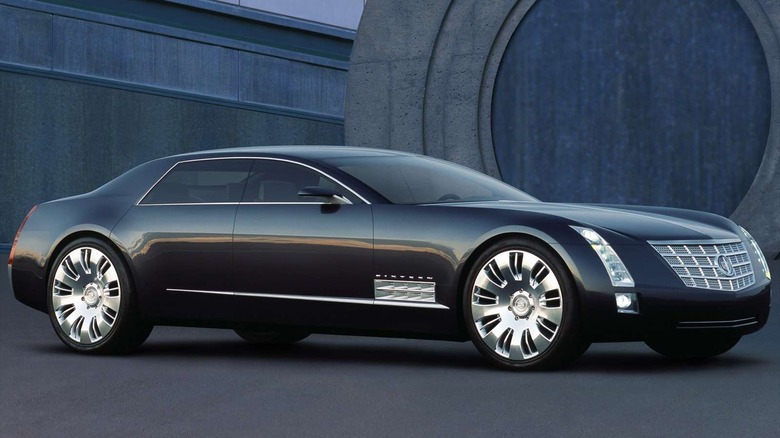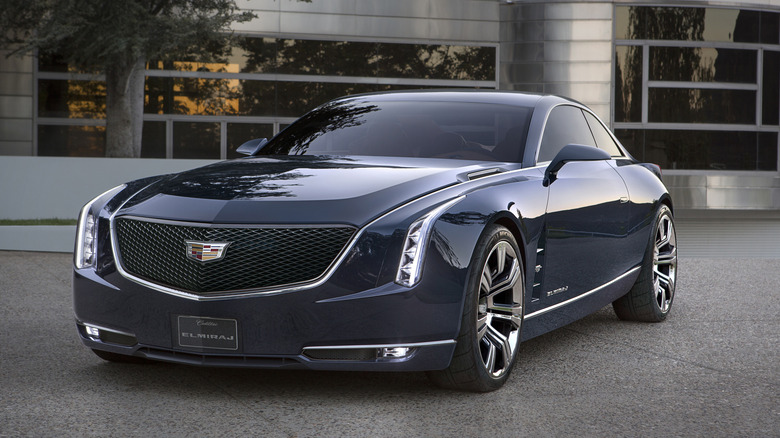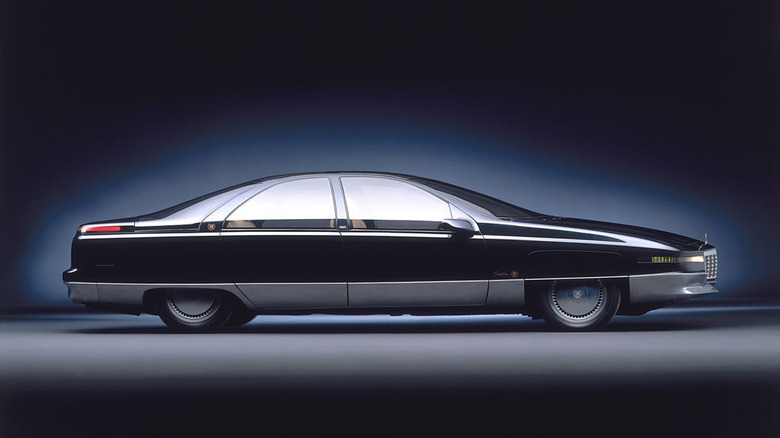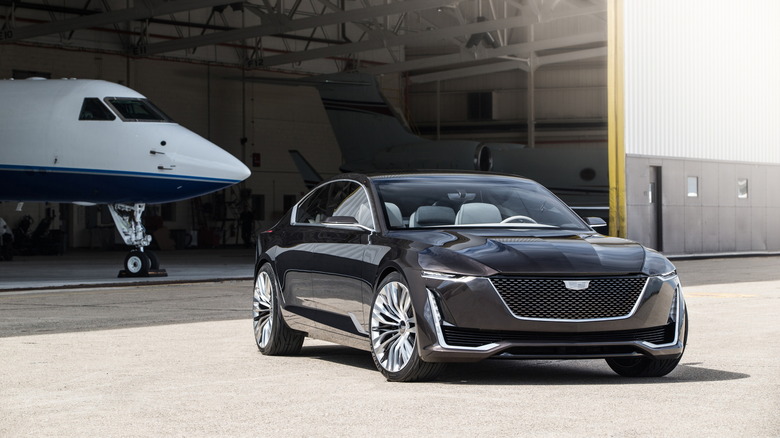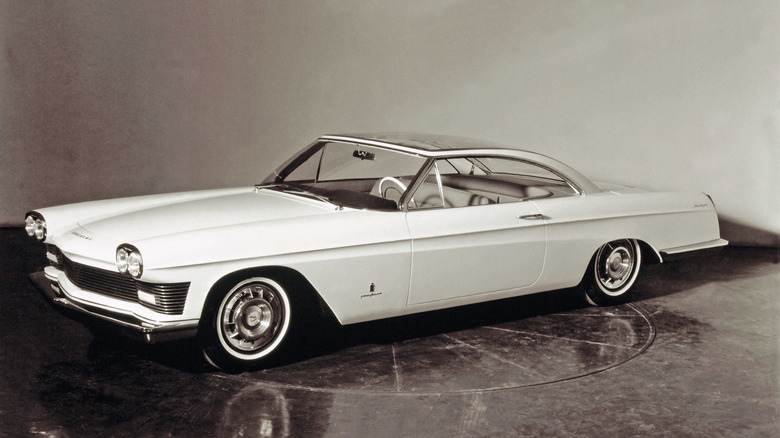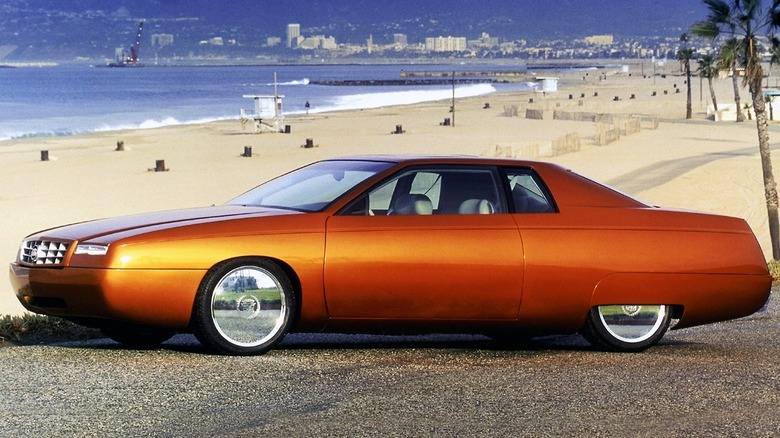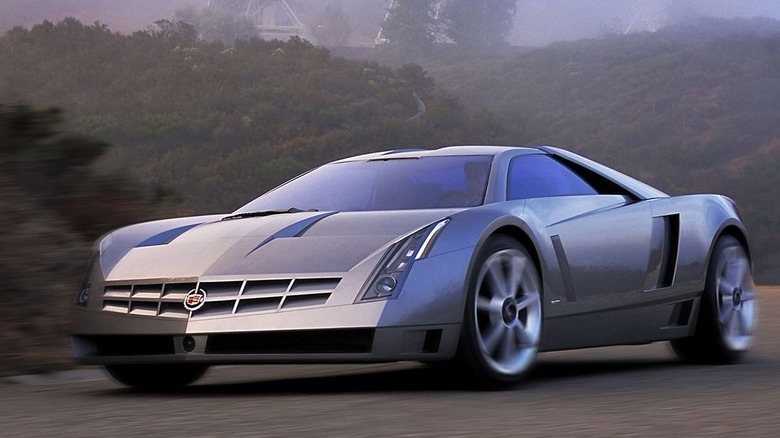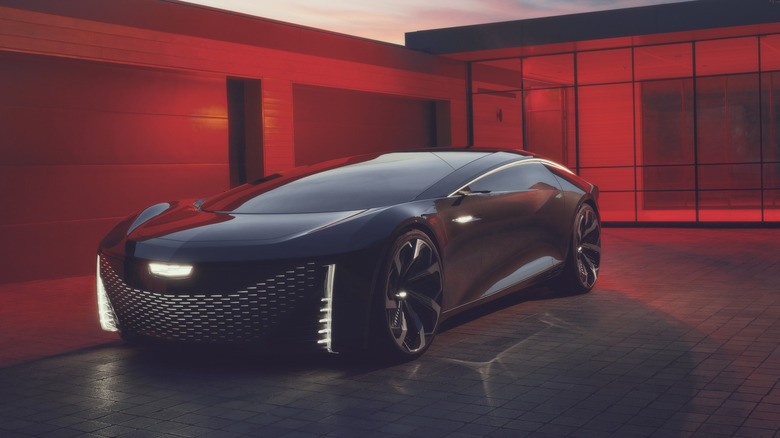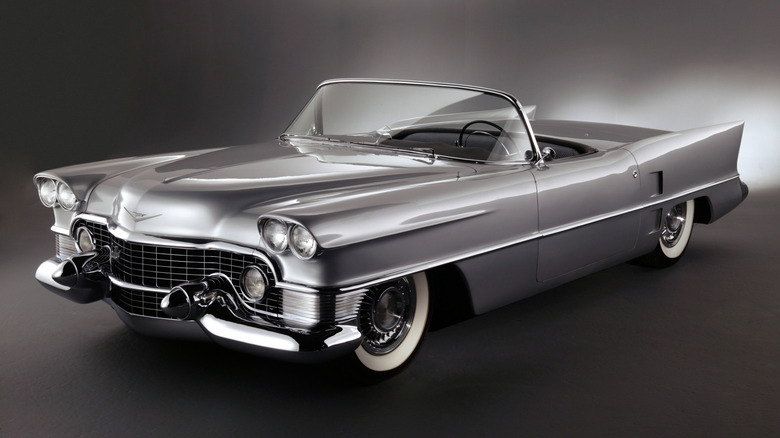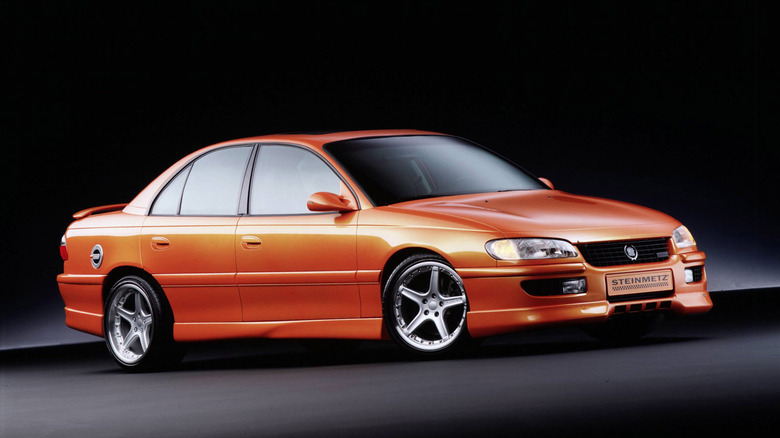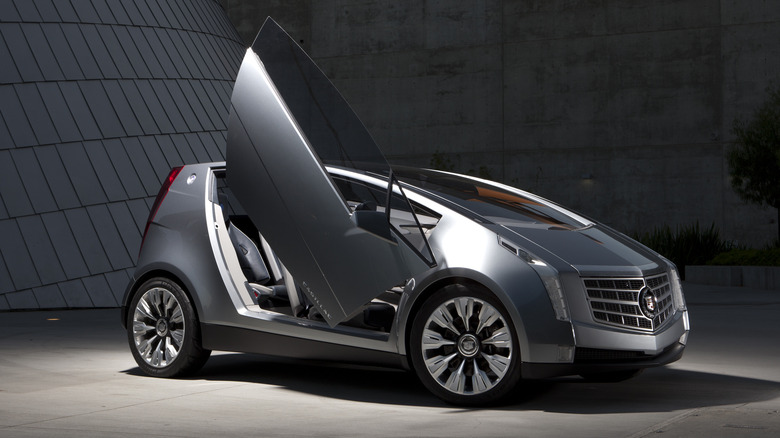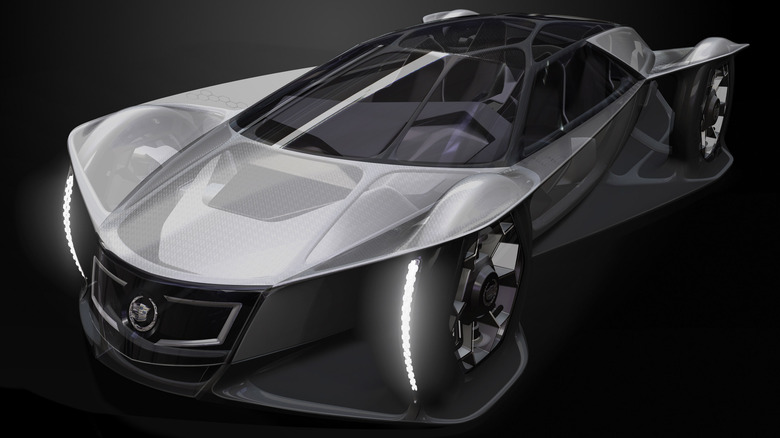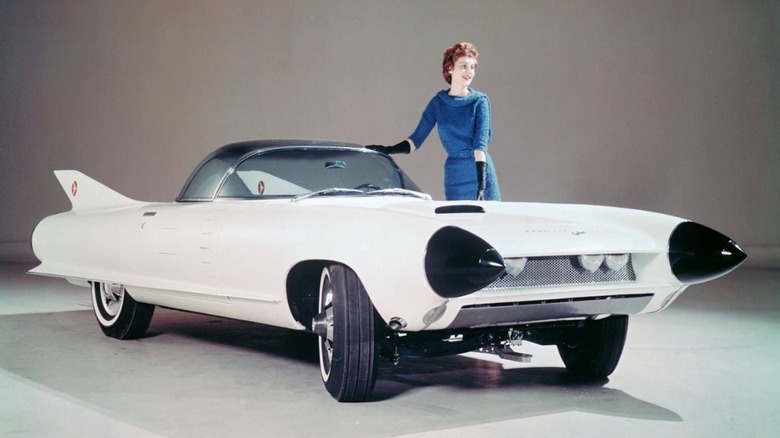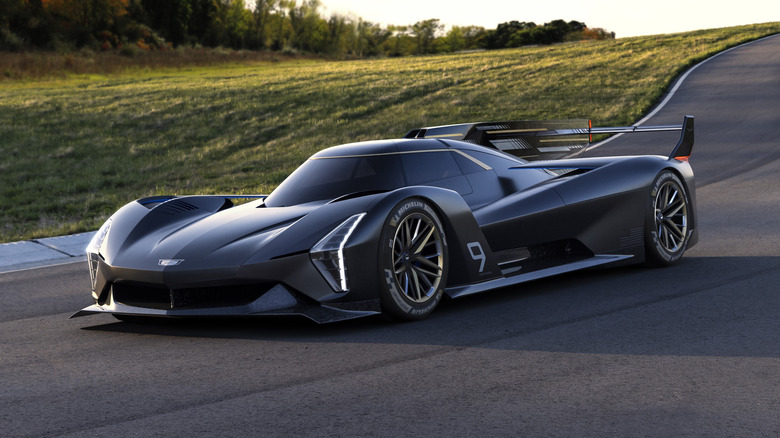The 15 Best Cadillac Concept Cars Of All Time
Cadillac was once the top-selling luxury car brand in America, but now it's a shadow of its former self. Its sales have been in decline for years, and the brand struggles to keep up with much of its foreign competition. However, over the years, it has shown off plenty of new ideas through its dozens of concept cars. These range from V12-engined supercars to pod-like autonomous luxury vehicles, but in the vast majority of cases, Cadillac has never put these cars into production, even if they've been very well received by the press and public alike.
Some critics have argued that the brand doesn't have many chances left to reclaim its place in the luxury car market and that continual underinvestment from parent company GM might eventually kill off Cadillac entirely. However, the latest company initiative focuses on electrification, and it seems like, for once, Cadillac is serious about radically overhauling its lineup. As the brand prepares to launch its first electric car, the Lyriq, in 2023, it's a good time to take a look through Cadillac's back catalog of concepts and wonder if any of them could have reversed the fortunes of the Cadillac brand.
Cadillac Ciel
The Ciel is a grand, imposing luxury convertible that was unveiled in 2011 at the Pebble Beach Concours in California. Cadillac called it, "a modern reimagining of the large four-seat convertibles of our past," and the car was met with a very positive reception from the press and public alike. The car was powered by a twin-turbocharged 3.6L V6 making 425 horsepower and featured a mild hybrid system for additional boost. It debuted after several years of consistently declining sales for Cadillac, and its appearance had fans hoping that a production version would be made to challenge the dominance of the Mercedes S-Class and BMW 7 Series in the high-end luxury segment.
After the car's unveiling, GM went quiet on the fate of the Ciel for two years, but then in 2013, it emerged that executives had scrapped the project after deciding that it would cost too much to develop for production. It was not the news that fans wanted, especially since it left the brand without a flagship luxury vehicle. As it turns out, the Ciel would mark the start of a particularly uncertain decade for Cadillac, where it would hop between one flimsy sales strategy and another, without much conviction of what path the brand wanted to take.
Cadillac Sixteen
Throughout the decades, Cadillac has always been keen to remind buyers of its golden era, sometimes at the expense of designing cars to future-proof the brand. The 2003 Sixteen concept was a particularly self-indulgent piece of nostalgia, and it featured a V16 engine to pay homage to the original 1930 Sixteen flagship car. Like its predecessor, the Sixteen concept was physically huge, and its interior was draped in leather and polished wood. It would have been fast too, in theory at least, as that monstrous V16 engine was capable of making a claimed 1,000 horsepower. However, Cadillac never conducted any real-world performance test, as the Sixteen was always designed primarily as a show car.
The Sixteen did debut with one innovative piece of technology, called Displacement on Demand. The car was able to shut down parts of its engine at the flick of a switch, helping to reduce fuel consumption when it didn't need the extra power. It was able to run on four, eight, or sixteen cylinders, and this tech would make its production debut in various GM products just one year later, according to Autoevolution. The car itself, however, was never intended for production, instead, it was merely to show off the brand's new design language that would make its way to production vehicles in the following years.
Cadillac Elmiraj
One of a series of promising concepts in recent years, the Elmiraj was explicitly designed to, "take up from where the memorable Ciel concept left off," according to GM's press release at the time. It took many of the same selling points from the Ciel and repackaged them with more contemporary styling and a fixed roof, rather than the Ciel's open cabin. It was aimed squarely at taking on the Germans, with Cadillac executives hinting that their benchmark for the concept was the Mercedes S-Class, although it could just as easily have been the BMW 6 Series.
Like the grand concepts before it, the Elmiraj didn't make it to production, despite GM execs fueling rumors that suggested it might do. It seemed like the car was more feasible for production than some other concepts, as it sported a 450 horsepower twin-turbocharged V8 engine that was based on the production V6 in the 2014 CTS Vsport, according to GM's press release. Likewise, it was built on the platform of a vehicle that GM said was already slated for production, which would have significantly reduced development costs over building an entirely separate platform. Still, it seems like company executives didn't want to put up the development capital for the project, and the Elmiraj remained a potential-filled one-off show car.
Cadillac Voyage
The phrase "cutting-edge performance technology" might not be the first thing that most people will associate with Cadillac. But, in 1988, the company sought to change that, showing off the futuristic Voyage, which was chock-full of all manner of new-age tech and boasted a drag coefficient of just 0.28, made possible thanks to an early form of active aero. The Voyage also did away with the boxy lines of previous-generation Cadillacs and paved the way for a new, more streamlined design language to emerge.
Among its other innovations were an early form of navigation software, orthopedically-designed seats with memory profiles, and automatic switching between rear-wheel drive and all-wheel drive for optimal traction. In today's market, these are standard luxury features, but back in the Eighties, this technology was genuinely groundbreaking. Many of these innovations would reach production in the decade that followed, but tougher competition from similarly tech-heavy foreign rivals limited Cadillac's ability to capitalize on this early lead. As well as being futuristic, the Voyage was seriously fast, with an estimated top speed of roughly 200 mph, although this was never officially tested.
Cadillac Escala
Another Pebble Beach Concours special, the Escala debuted in 2016 as a supposed preview to the production super-luxury flagship car that was going to take on the Mercedes S-Class and BMW 7 Series. Reports at the time seemed to suggest that a production version of the Escala would be imminent, and two years later in 2018, it was confirmed that executives had given the car the green light for production to begin in 2021. The car would be built on the existing CT6 platform, according to CNET, and start at around the $100,000 mark.
Fast forward to 2022, and there is no sign of the car nor any word on whether a production run is still planned. The design team behind the car released another sketch of the Escala in 2021, but with no further context. It now seems likely that Cadillac's push for electrification, combined with the supply chain issues caused by the pandemic, have likely meant that the Escala project has been given the ax altogether. Cadillac's web page for the Escala makes no reference to a planned production run, and the only "upcoming model" listed on the site is the 2023 Lyriq EV.
Cadillac Starlight
Pininfarina has a long and complicated history with Cadillac, but one of the Italian studio's earliest Cadillac-commissioned concepts is the Starlight. Unveiled in 1959, the Starlight is one of a series of four concepts that Pininfarina made for Cadillac over a three-year period, and it featured a unique roof made from a single piece of curved Plexiglass. Instead of a traditional headliner, the concept featured four articulated metal plates that, when not in use, could be folded down as one and stored away behind the parcel shelf.
It seems that GM bosses weren't too keen on this design direction, but Pininfarina nonetheless continued to make designs for the Cadillac brand over the following years, culminating in the Cadillac Jacqueline, a car named after the wife of President John F. Kennedy. What happened to most of these concepts, including the Starlight, remains unknown, although it has been confirmed that the Jacqueline was eventually sold off to a Belgian Ferrari dealer. Perhaps the Starlight will make a reappearance at some point in the future, but for now, it remains a lost concept, with only Pininfarina's original images to remember it by.
Cadillac Eldorodo
Since the 1930s, California has been home to some of America's most famous hot rod builders, and since the Cadillac Eldorado was such a popular car throughout the mid-20th Century, it became a favorite among the rodding community. In 2000, Cadillac unveiled a concept to pay tribute to that heritage, called the Eldorodo, or EldoRODo as it was styled in some articles at the time. The concept was based on a 2000 Eldorado, but sat four inches lower, and tilted the front and rear window glass an extra 10 degrees to fit the lowered roofline. Full-length side skirts also covered the rear wheels.
The car was primarily built as a styling exercise, perhaps also as a publicity stunt, in an attempt to prop up the Eldorado's flagging sales. It received little interest at the time, partly because the car used a standard 300 horsepower Northstar engine with no performance improvements over a regular Eldorado. Still, the idea of a retro-modern production hot rod had potential, if the company had developed it further. They didn't, and the Eldorado was axed just two years later.
Cadillac Cien
The Cien was a mid-engined supercar featuring a 750 horsepower 7.5L V12. It debuted in 2002 to celebrate Cadillac's 100th birthday, and the car was the first of its kind, with an angular, modern design that went on to influence later production models. However, the car itself never made production, as like so many of Cadillac's other concepts, it was only ever intended to be a show car. It was, however, fully homologated for road use, making it the most powerful road-legal factory Cadillac to date, according to Motor1.
The Cien featured several innovations that are now standard for supercar manufacturers, with a carbon-composite construction, six-speed paddle-shift automatic transmission, and active air vents that opened and closed to aid cooling. The car was built by Prodrive, a UK-based engineering firm that's been responsible for everything from Colin McRae's World Rally Championship-winning Subarus to Ferrari's Le Mans cars, reports Jalopnik. At the time, the Cien seemed too far-fetched for Cadillac to realistically ever put into production, and unsurprisingly, only the one concept was ever produced. The car did, however, feature prominently in the 2005 movie The Island, which starred Ewan McGregor and Scarlett Johansson.
Cadillac InnerSpace
Like many automakers, Cadillac has toyed with the idea of full autonomy in recent years. The InnerSpace debuted in January 2022 as one of a series of autonomous concepts that might possibly influence future production models. It's a luxurious two-seater, and it doesn't bother with a steering wheel or traditional driving controls, instead replacing them with a large screen. The idea was reportedly to create a luxurious lounge-like interior that "maintain[s] the sensation of arriving in a Cadillac." The two front passengers can slide their seats together to make a loveseat arrangement, should they want.
With the myriad regulatory and legal issues that are involved with getting fully autonomous vehicles on the road, it doesn't seem like the InnerSpace concept is destined for production any time soon. Questions also remain over how many drivers would be happy to totally relinquish control of their vehicle, especially with the ongoing investigation by the NHTSA over the safety of Tesla's Autopilot. Still, the InnerSpace remains an interesting insight into how Cadillac might try to win over consumers if autonomous cars do ever become commonplace on American roads.
Cadillac Le Mans
The 1953 Cadillac Le Mans was a styling exercise built to demonstrate the brand's new design language, and it debuted at the 1953 GM Motorama show. It was commissioned by Harley Earl, General Motors' first Vice President of Design, and four examples were made. Its name was taken from the famous 24-hour race, in honor of the fact that Cadillac had competed there in 1950. In the modern era, it's unusual for concept cars to be sold off to private collectors after their time on the show circuit is over, but in the early '50s, it was more common, and it's exactly what Earl did with the Le Mans.
According to Autoweek, all four concepts were sold or given to Earl's well-connected friends, with the intention of building more positive publicity for the Cadillac brand. One went to a shoe magnate called Harry Karl, and another to a Beverly Hills Cadillac dealer who Earl had previously done business with. The third ended up in the hands of celebrity custom car builder George Barris but was later destroyed by a fire. However, Autoweek reports that the fourth car went to Oklahoma to star in a local exhibition, then disappeared the following week. It has never been seen again, despite various attempts over the years to track it down. Autoweek estimates that the car is worth up to $2 million today, although it's unlikely that the car will now be found intact seven decades after it first went missing.
Cadillac Steinmetz Catera
The Opel Omega-based Cadillac Catera was dogged by sluggish sales and recalls, and so in 1999 Cadillac decided it needed a high-performance version. The company enlisted German tuners Steinmetz, who had experience tuning the Omega, to create a concept in order to gauge the public demand for the car. It featured a 284 horsepower supercharged V6 and a number of other performance upgrades, and was finished in bright orange paint. The interior of the car was also drastically different from a regular Catera, with leather-clad sports seats and drilled aluminum pedals to add a sportier feel.
However, a sportier Catera was still a Catera, and by the time of the Steinmetz concept's debut, the car had been irreversibly labeled as something that only older buyers would ever consider. So, the concept was met with a lukewarm reaction by the press and the public. Consumer Guide reports that the Steinmetz Catera was also meant to test the market's appetite for a performance-oriented Blackfin sub-brand, but the indifferent reaction to the concept convinced company bosses to not only shelve plans for a hotter Catera, but for the Blackfin line altogether. The Catera would eventually be replaced by the CTS, which gained a much better reputation and eventually spawned a performance line of its own, CTS-V.
Cadillac Urban Luxury
One of the most surprising reveals of the 2010 Los Angeles Auto Show, the Urban Luxury Concept, or ULC, was Cadillac's first foray into the world of city cars. It was roughly the size of a Mini Cooper, but it featured Lambo-style scissor doors and a plush interior. Its engine was a 1.0L turbocharged inline-three, which Cadillac claimed was good for 56 mpg in the city and 65 mpg on the highway. At the time, Car and Driver poured cold water on the idea of the Urban Luxury ever reaching production, simply because the market for smaller luxury vehicles in America was near non-existent.
Ironically, Green Car Reports also pointed out that cheap gas prices meant that American buyers were abandoning smaller cars in favor of large SUVs and crossovers. It was suggested at the time that the Urban Luxury might have been a way for Cadillac to relaunch itself into the European market, as Europe has always favored smaller cars. But, the brand's less-than-stellar image across the pond, combined with Cadillac's limited development resources, meant that the Urban Luxury remained a curious one-off.
Cadillac Aera
Also unveiled at the 2010 Los Angeles Auto Show was the Aera, a cutting-edge virtual concept that was produced by Cadillac as an entry to the show's in-house design competition. The car utilized a unique 3D-printed lattice structure and a mono-formed frame to keep its weight under 1,000 pounds and featured a flexible polymer skin as an alternative to conventional panels and glass. The car's choice of powertrain was also highly unusual, as the car was driven through a pneumatic drive system that ran on compressed air stored in a 10,000 psi air tank. This tank was enough to give the Aera a claimed total range of 1,000 miles.
The concept won the Design Award at that year's show, but it's hard to imagine the car ever making it to reality in any form. However, the idea of a 3D-printed lattice structure to save weight did have some real-world applications, albeit in a very different form to making a car chassis. Silicon Valley startup Carbon 3D would later go on to develop a similar polyurethane-based lattice that would enter production in the high-end Adidas 4D line of running shoes. India-based Tata Motors also began development work on a car that ran on compressed air around the time that the Aera was unveiled, but it seems like the project was deemed unfeasible for production and eventually shelved.
Cadillac Cyclone
A uniquely-styled concept that was unveiled in 1959, the Cadillac Cyclone took heavy inspiration from the American fascination with space travel at the time. It made its debut at the inaugural Daytona 500 and was designed by Harley Earl and Bill Mitchell, two of GM's most lauded designers from the era. The car was designed as a rolling testbed for future technologies, and its biggest innovation was the sensors in the black nose cones at the front of the car, that could alert drivers of nearby objects. Proximity sensors are of course a common feature on cars today, but at the time this technology was practically unheard of.
When the sensor detected rain, it could automatically raise the one-piece bubble roof, which was partly coated in vaporized silver to deflect the sun's rays. The car also featured sliding doors for easier access in and out of the car, and an exterior speaker system so that the driver could broadcast their voice to someone outside the car. The Cyclone made a big impression on buyers when it debuted, and several of its features eventually found their way to production Cadillacs.
Cadillac Project GTP
Unveiled in June 2022, the Project GTP marks a return to endurance racing for Cadillac. It's only been shown in concept form at the moment, but the brand says it will be ready for testing over the summer and then will be competing on track in 2023. It's built to LMDh regulations, so it features a 5.5L V8 engine combined with a regulation Bosch electric motor. Total power output is capped at 671 horsepower. Cadillac has confirmed that the car is set to compete at Le Mans in 2023 and will contest full seasons in both the IMSA WeatherTech Sportscar Championship and the FIA World Endurance Championship.
Although Cadillac has seen plenty of recent success in IMSA, claiming the overall title in 2017, 2018, and 2021 according to Jalopnik, the brand has long been missing from the global endurance racing stage. It's been over 20 years since Cadillac last competed at Le Mans, and with an expanded hypercar class that now includes BMW, Acura, and Ferrari, it seems like the 2023 Le Mans race is shaping up to be the best in decades. Hopefully, this return to high-profile global motorsport will also provide a sense of brand direction for Cadillac, which has some serious work to do if it wants to get anywhere close to regaining its place as a world-class luxury car manufacturer.
